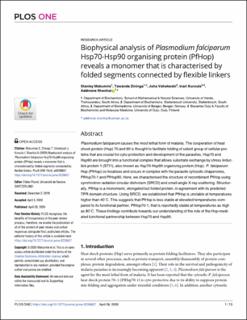| dc.contributor.author | Makumire, Stanley | |
| dc.contributor.author | Zininga, Tawanda | |
| dc.contributor.author | Vahokoski, Juha | |
| dc.contributor.author | Kursula, Inari | |
| dc.contributor.author | Shonhai, Addmore | |
| dc.date.accessioned | 2021-06-24T10:42:27Z | |
| dc.date.available | 2021-06-24T10:42:27Z | |
| dc.date.created | 2021-02-15T13:34:19Z | |
| dc.date.issued | 2020 | |
| dc.identifier.issn | 1932-6203 | |
| dc.identifier.uri | https://hdl.handle.net/11250/2761097 | |
| dc.description.abstract | Plasmodium falciparum causes the most lethal form of malaria. The cooperation of heat shock protein (Hsp) 70 and 90 is thought to facilitate folding of select group of cellular proteins that are crucial for cyto-protection and development of the parasites. Hsp70 and Hsp90 are brought into a functional complex that allows substrate exchange by stress inducible protein 1 (STI1), also known as Hsp70-Hsp90 organising protein (Hop). P. falciparum Hop (PfHop) co-localises and occurs in complex with the parasite cytosolic chaperones, PfHsp70-1 and PfHsp90. Here, we characterised the structure of recombinant PfHop using synchrotron radiation circular dichroism (SRCD) and small-angle X-ray scattering. Structurally, PfHop is a monomeric, elongated but folded protein, in agreement with its predicted TPR domain structure. Using SRCD, we established that PfHop is unstable at temperatures higher than 40°C. This suggests that PfHop is less stable at elevated temperatures compared to its functional partner, PfHsp70-1, that is reportedly stable at temperatures as high as 80°C. These findings contribute towards our understanding of the role of the Hop-mediated functional partnership between Hsp70 and Hsp90. | en_US |
| dc.language.iso | eng | en_US |
| dc.publisher | Public Library of Science | en_US |
| dc.rights | Navngivelse 4.0 Internasjonal | * |
| dc.rights.uri | http://creativecommons.org/licenses/by/4.0/deed.no | * |
| dc.title | Biophysical analysis of Plasmodium falciparum Hsp70-Hsp90 organising protein (PfHop) reveals a monomer that is characterised by folded segments connected by flexible linkers | en_US |
| dc.type | Journal article | en_US |
| dc.type | Peer reviewed | en_US |
| dc.description.version | publishedVersion | en_US |
| dc.rights.holder | Copyright 2020 Makumire et al. | en_US |
| dc.source.articlenumber | e0226657 | en_US |
| cristin.ispublished | true | |
| cristin.fulltext | original | |
| cristin.qualitycode | 1 | |
| dc.identifier.doi | 10.1371/journal.pone.0226657 | |
| dc.identifier.cristin | 1889914 | |
| dc.source.journal | PLOS ONE | en_US |
| dc.identifier.citation | PLOS ONE. 2020, 15 (4), e0226657. | en_US |
| dc.source.volume | 15 | en_US |
| dc.source.issue | 4 | en_US |

